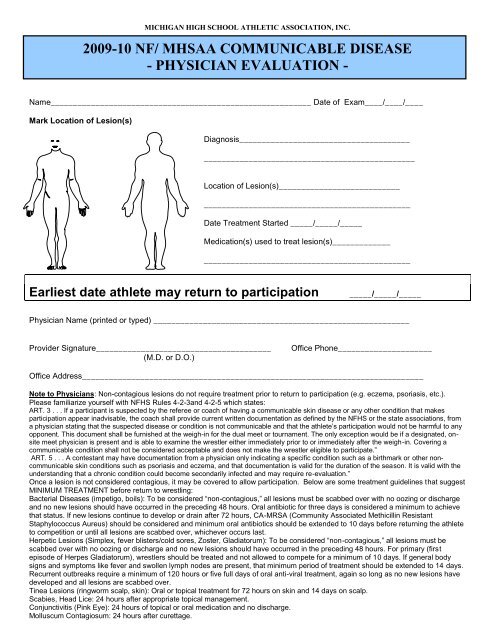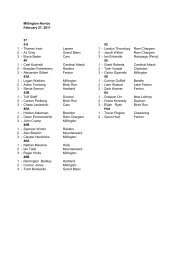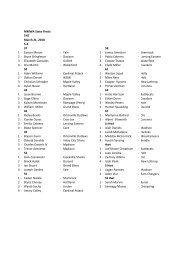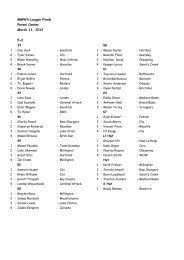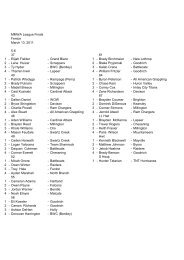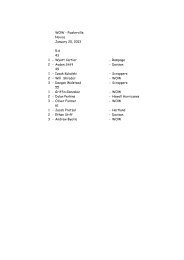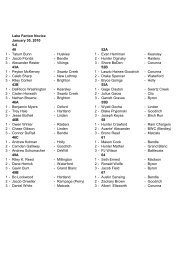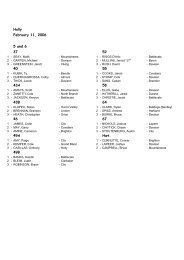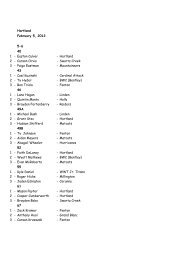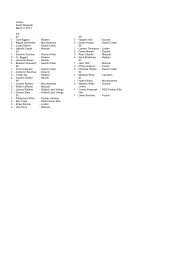Mid Michigan Wrestling Association
Mid Michigan Wrestling Association
Mid Michigan Wrestling Association
You also want an ePaper? Increase the reach of your titles
YUMPU automatically turns print PDFs into web optimized ePapers that Google loves.
MICHIGAN HIGH SCHOOL ATHLETIC ASSOCIATION, INC.<br />
2009-10 NF/ MHSAA COMMUNICABLE DISEASE<br />
- PHYSICIAN EVALUATION -<br />
Name__________________________________________________________ Date of Exam____/____/____<br />
Mark Location of Lesion(s)<br />
Diagnosis______________________________________<br />
_______________________________________________<br />
Location of Lesion(s)___________________________<br />
______________________________________________<br />
Date Treatment Started _____/_____/_____<br />
Medication(s) used to treat lesion(s)_____________<br />
______________________________________________<br />
Earliest date athlete may return to participation<br />
_____/_____/_____<br />
Physician Name (printed or typed) _________________________________________________________<br />
Provider Signature_______________________________________<br />
(M.D. or D.O.)<br />
Office Phone_____________________<br />
Office Address____________________________________________________________________________<br />
Note to Physicians: Non-contagious lesions do not require treatment prior to return to participation (e.g. eczema, psoriasis, etc.).<br />
Please familiarize yourself with NFHS Rules 4-2-3and 4-2-5 which states:<br />
ART. 3 . . . If a participant is suspected by the referee or coach of having a communicable skin disease or any other condition that makes<br />
participation appear inadvisable, the coach shall provide current written documentation as defined by the NFHS or the state associations, from<br />
a physician stating that the suspected disease or condition is not communicable and that the athlete’s participation would not be harmful to any<br />
opponent. This document shall be furnished at the weigh-in for the dual meet or tournament. The only exception would be if a designated, onsite<br />
meet physician is present and is able to examine the wrestler either immediately prior to or immediately after the weigh-in. Covering a<br />
communicable condition shall not be considered acceptable and does not make the wrestler eligible to participate.”<br />
ART. 5 . . . A contestant may have documentation from a physician only indicating a specific condition such as a birthmark or other noncommunicable<br />
skin conditions such as psoriasis and eczema, and that documentation is valid for the duration of the season. It is valid with the<br />
understanding that a chronic condition could become secondarily infected and may require re-evaluation.”<br />
Once a lesion is not considered contagious, it may be covered to allow participation. Below are some treatment guidelines that suggest<br />
MINIMUM TREATMENT before return to wrestling:<br />
Bacterial Diseases (impetigo, boils): To be considered “non-contagious,” all lesions must be scabbed over with no oozing or discharge<br />
and no new lesions should have occurred in the preceding 48 hours. Oral antibiotic for three days is considered a minimum to achieve<br />
that status. If new lesions continue to develop or drain after 72 hours, CA-MRSA (Community Associated Methicillin Resistant<br />
Staphylococcus Aureus) should be considered and minimum oral antibiotics should be extended to 10 days before returning the athlete<br />
to competition or until all lesions are scabbed over, whichever occurs last.<br />
Herpetic Lesions (Simplex, fever blisters/cold sores, Zoster, Gladiatorum): To be considered “non-contagious,” all lesions must be<br />
scabbed over with no oozing or discharge and no new lesions should have occurred in the preceding 48 hours. For primary (first<br />
episode of Herpes Gladiatorum), wrestlers should be treated and not allowed to compete for a minimum of 10 days. If general body<br />
signs and symptoms like fever and swollen lymph nodes are present, that minimum period of treatment should be extended to 14 days.<br />
Recurrent outbreaks require a minimum of 120 hours or five full days of oral anti-viral treatment, again so long as no new lesions have<br />
developed and all lesions are scabbed over.<br />
Tinea Lesions (ringworm scalp, skin): Oral or topical treatment for 72 hours on skin and 14 days on scalp.<br />
Scabies, Head Lice: 24 hours after appropriate topical management.<br />
Conjunctivitis (Pink Eye): 24 hours of topical or oral medication and no discharge.<br />
Molluscum Contagiosum: 24 hours after curettage.
NFHS/ MHSAA PHYSICIAN RELEASE FOR WRESTLER<br />
TO PARTICIPATE WITH SKIN LESION(S)<br />
The NFHS Sports Medicine Advisory Committee conducted a survey among specialty, academic, public health and<br />
primary care physicians and reviewed extensively the literature available on the communicability of various skin lesions at<br />
different stages of disease and treatment. No definitive data exists that allow us to absolutely predict when a lesion is no<br />
longer shedding organisms that could be transmitted to another. Another finding from the survey was the significant<br />
differences that exist among physicians relating to when they will permit a wrestler to return to participation after having a<br />
skin infection.<br />
Neither the NFHS nor the NFHS Sports Medicine Advisory Committee presumes to dictate to professionals how to<br />
practice medicine. Neither is the information on this form meant to establish a standard of care. The NFHS Sports<br />
Medicine Advisory Committee does feel, however, that the guidelines included on the form represent a summary<br />
consensus of the various responses obtained from the survey, from conversations and from the literature. The committee<br />
also feels that the components of the form are very relevant to addressing the concerns of coaches, parents, wrestlers<br />
and physicians that lead to the research into this subject and to the development of this form.<br />
GOALS FOR ESTABLISHING A WIDELY USED FORM:<br />
1. Protect wrestlers from exposure to communicable skin disorders. Although most of the skin lesions being discussed<br />
generally have no major long term consequences and are not life threatening, some do have morbidity associated with<br />
them and student-athletes should be protected from contracting skin disorders from other wrestlers or contaminated<br />
equipment such as mats.<br />
2. Allow wrestlers to participate as soon as it is reasonably safe for them and for their opponents and/or teammates using<br />
the same mat.<br />
3. Establish guidelines to help minimize major differences in management among physicians who are signing “return to<br />
competition forms”. Consistent use of these guidelines should protect wrestlers from catching a skin disease from<br />
participation and should protect them from inequalities as to who can or cannot participate.<br />
4. Provide a basis to support physician decisions on when a wrestler can or cannot participate. This should help the<br />
physician who may face incredible pressure from many fronts to return a youngster to competition ASAP. This can involve<br />
any student athlete who never wins a match or the next state champion with a scholarship pending.<br />
IMPORTANT COMPONENTS FOR AN EFFECTIVE FORM:<br />
1. Inclusion of the applicable NFHS wrestling rule so physicians will understand that covering a contagious lesion is not an<br />
option that is allowed by rule. Covering a non-contagious lesion after adequate therapy to prevent injury to lesion is<br />
acceptable.<br />
2. Inclusion of the date and nature of treatment and the earliest date a wrestler can return to participation. This should<br />
minimize the need for a family to incur the expense of additional office visits as occurs when a form must be signed within<br />
three days of wrestling as some do.<br />
3. Inclusion of a “body gram” with front and back views should clearly identify the lesion in question. Using non-black ink<br />
to designate skin lesions should result in less confusion or conflict. Also including the number of lesions protects against<br />
spread after physician visit.<br />
4. Inclusion of guidelines for minimum treatment before returning the wrestler to action as discussed above. This should<br />
enhance the likelihood that all wrestlers are managed safely and fairly.<br />
5. Inclusion of all of the components discussed has the potential to remove the referee from making a medical decision. If<br />
a lesion is questioned, the referee’s role could appropriately be only to see if the coach can provide a fully completed<br />
medical release form allowing the wrestler to wrestle.<br />
This form may be reproduced, if desired and can be edited in any way for use by various individuals or organizations. In<br />
addition, the NFHS Sports Medicine Advisory Committee would welcome comments for inclusion in future versions as this<br />
will continue to be a work in progress.<br />
Revised/Approved April 2009<br />
www.nfhs.org<br />
www.mhsaa.com


